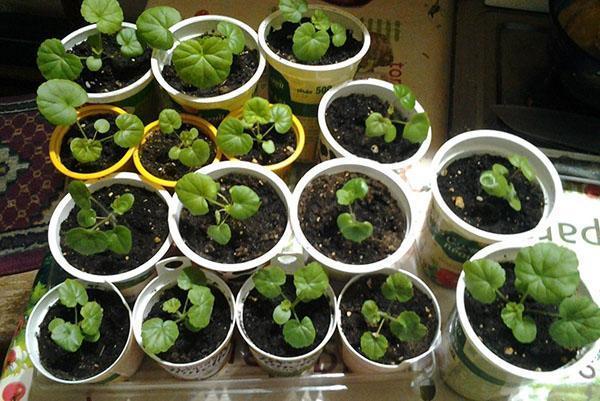Growing seedlings of pelargonium
 Pelargonium requires special care after transplanting germinated seeds into the ground. For transplanting, it is necessary to properly prepare the soil. Sandy loam soil is best suited for growing geraniums. In peat soil, pelargonium will not form buds, since its root system will suffer from a lack of oxygen. Geranium does not like stagnant water, and peat soil retains moisture well. Because of this, the root system of pelargonium can rot. Geranium growing in unsuitable soil is more likely to be affected by fungal and viral diseases.
Pelargonium requires special care after transplanting germinated seeds into the ground. For transplanting, it is necessary to properly prepare the soil. Sandy loam soil is best suited for growing geraniums. In peat soil, pelargonium will not form buds, since its root system will suffer from a lack of oxygen. Geranium does not like stagnant water, and peat soil retains moisture well. Because of this, the root system of pelargonium can rot. Geranium growing in unsuitable soil is more likely to be affected by fungal and viral diseases.
Seedling containers
You also need to choose the right seedling containers. Plastic cups with drainage holes will do. A seed in a close glass pelargonium quickly forms a dense earthen lump. When the root system of pelargonium is completely covered with earth, the active growth of the green mass of geranium will begin. The drainage holes will allow water to drain off, allowing the root system to develop faster.
Soil preparation
Loosening the soil will saturate the soil with oxygen, which is necessary for the rapid development of the seedling root system. To disinfect the soil, the soil is watered with a solution of potassium permanganate. Potassium permanganate is dissolved in hot water. The solution should be a deep purple color.
As soon as the water touches the soil surface, it instantly cools. But if the solution gets on the container, there is a risk of melting the plastic. Therefore, it is necessary to water the soil with a solution carefully.
When the potassium permanganate solution is absorbed into the soil, germinated seeds can be planted in seedling containers. In order not to damage the young roots of the seed, you need to use tweezers or a culinary skewer. The seed is carefully lifted and transplanted into a container for seedlings.
It is impossible to deeply bury the seeds in the soil. They are placed in a 0.5 mm deep well. Only roots should be in the ground. As the seed grows, it is covered with earth.
Fight seedling diseases
Young shoots can infect fungal diseases. The most common seedling disease is black leg. In order to prevent infection with this disease, after the leaves appear, sprinkle the plant with garden perlite. This material holds spores of fungal diseases well.
If you often water a young sprout of pelargonium, then its root system will not develop. Water the plant when the topsoil dries up and the roots grow deep into the soil.